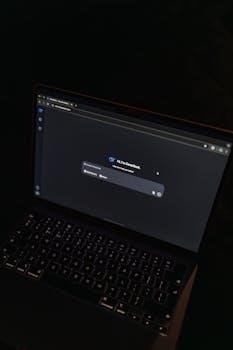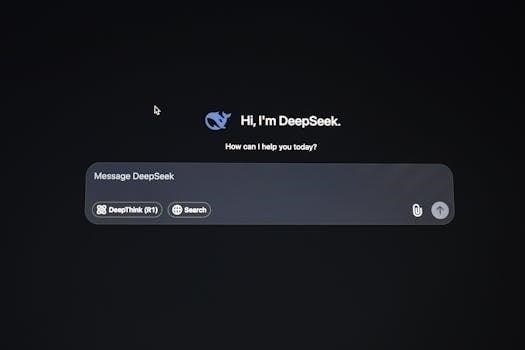5e DM Screen PDF⁚ A Comprehensive Guide
A 5e DM screen PDF is a valuable resource for Dungeon Masters, offering quick access to essential rules, tables, and information during D&D sessions․ These PDFs are designed for easy printing and assembly, providing a convenient and customizable tool to enhance gameplay and streamline the DM’s role․
What is a 5e DM Screen?
A 5e DM screen is a physical or digital barrier positioned between the Dungeon Master (DM) and the players during a Dungeons & Dragons 5th Edition game․ Its primary function is to conceal the DM’s notes, dice rolls, and other game-related information from the players, maintaining an element of surprise and preventing metagaming․ Typically, the DM screen features essential game rules, tables, and reference information on the DM’s side, serving as a quick guide during gameplay․
A DM screen helps streamline the game by providing easy access to frequently used rules and information, reducing the need to constantly flip through rulebooks․ It enhances the immersive experience for players by keeping the DM’s preparations and behind-the-scenes activities hidden․ This separation preserves the mystery and suspense of the game․ DM screens come in various formats, including physical screens made of cardboard or other materials and digital versions in PDF format that can be used on tablets or laptops․ Many DMs also customize their screens with campaign-specific notes and artwork to further tailor the tool to their individual needs․
Benefits of Using a DM Screen
Employing a DM screen in your Dungeons & Dragons 5th Edition games offers numerous advantages that enhance both the DM’s and the players’ experience․ One of the primary benefits is the concealment of sensitive game information․ By shielding dice rolls, notes, and upcoming encounters from player view, the DM maintains an element of surprise and prevents players from gaining unintended knowledge, preserving the integrity of the game․

A DM screen also serves as a convenient reference tool, providing quick access to essential rules, tables, and monster statistics; This reduces the need to constantly consult rulebooks, streamlining gameplay and maintaining its pace․ Furthermore, the DM screen can aid in organization․ It offers a dedicated space for the DM to keep track of initiative, player stats, and other important details, ensuring a smoother and more efficient game session․
Beyond practical benefits, a DM screen enhances immersion by creating a sense of separation between the DM’s world-building activities and the players’ immediate experience․ This contributes to a more engaging and mysterious atmosphere, enriching the overall D&D adventure․
Essential Information to Include on a 5e DM Screen
A well-organized 5e DM screen should feature critical information for quick reference during gameplay․ This includes commonly used rules such as armor class, saving throws, and conditions like poisoned or stunned․ Having these readily available minimizes rulebook consultation, ensuring a smoother, more engaging session․
The screen should also incorporate a list of common actions in combat, like attacking, dashing, or using objects, with brief descriptions of their effects․ This helps the DM adjudicate combat quickly and consistently․ Monster statistics, especially those relevant to the current adventure or campaign, are invaluable․ Including stats for frequently encountered creatures saves time and prevents interruptions․
Furthermore, the DM screen should contain tables for random encounters, weather conditions, and treasure generation, tailored to the game’s setting․ These add spontaneity and unpredictability to the game․ Finally, a section dedicated to player character information, such as passive perception scores and key abilities, can aid the DM in tailoring challenges and interactions, creating a more personalized and immersive experience for the players․
Where to Find Free 5e DM Screen PDFs
Numerous online resources offer free 5e DM screen PDFs for Dungeon Masters seeking to enhance their game․ Websites dedicated to Dungeons & Dragons, such as D&D Beyond and Wizards of the Coast’s official site, often host community-created content, including DM screens․ These resources may require a free account but provide access to a wealth of materials․
Fan-made content platforms like Reddit (r/DnD, r/dndnext) and DM’s Guild are treasure troves for resourceful DMs․ Users frequently share their custom-designed DM screens, tailored to specific campaigns or playstyles․ Third-party tabletop RPG sites like DriveThruRPG also offer free or pay-what-you-want DM screens, expanding the options․
When searching for free PDFs, be mindful of the source’s credibility to avoid malware or low-quality content․ Always preview the PDF before downloading to ensure it meets your needs․ Many free DM screens are available in both landscape and portrait orientations, with varying levels of customization․
Customizable 5e DM Screen PDFs
Customizable 5e DM screen PDFs offer Dungeon Masters the flexibility to tailor the information presented on their screens to suit their specific campaigns and playing styles․ These PDFs often come in editable formats, allowing DMs to add, remove, or modify sections as needed․ Popular file formats include fillable PDFs, which enable direct text input, and editable documents compatible with word processors․
Several online resources provide templates and tools for creating personalized DM screens․ Websites like Canva and Google Docs offer design templates that can be easily adapted to fit a DM screen layout․ These platforms often include drag-and-drop interfaces, making customization accessible to users with varying levels of design experience․
Customizable DM screens can include campaign-specific information, such as key NPCs, locations, and plot hooks․ DMs can also add rules clarifications, monster stats, and other frequently referenced details to streamline gameplay․ This level of personalization ensures that the DM screen is a relevant and efficient tool during sessions․
Creating Your Own 5e DM Screen PDF⁚ Tools and Resources
Creating a personalized 5e DM screen PDF involves utilizing various tools and resources to design and compile the necessary information․ Several software options cater to different skill levels and design preferences․ For those seeking a user-friendly experience, platforms like Canva and Google Docs offer customizable templates and drag-and-drop interfaces․ These tools are ideal for DMs who want to create visually appealing screens without extensive design knowledge․
For more advanced users, Adobe InDesign and Affinity Publisher provide greater control over layout and design elements․ These professional-grade software options allow for precise customization and the creation of high-quality PDFs․ Additionally, online resources like D&D Beyond and various fan-made websites offer valuable content and reference materials to include in the DM screen․
When creating a DM screen, consider organizing information into logical sections, such as combat rules, conditions, and NPC details․ Utilizing tables and bullet points can enhance readability and make it easier to find information quickly during gameplay․ Regularly updating the DM screen with campaign-specific details will ensure its continued relevance and usefulness․
Printing and Assembling Your DM Screen
Once you’ve finalized your 5e DM screen PDF, the next step involves printing and assembling it for practical use during your D&D sessions․ Start by selecting a suitable paper stock; heavier cardstock is recommended for durability and a professional feel․ Ensure your printer settings are optimized for the chosen paper to prevent smudging or poor image quality․
After printing, carefully trim each panel of the DM screen along the designated edges․ Consider laminating the panels to protect them from wear and tear, especially if you anticipate frequent use․ For assembly, various methods can be employed․ One popular approach involves using sturdy cardboard or foam board as a backing for each panel․ Attach the printed panels to the backing using adhesive spray or double-sided tape, ensuring a secure bond․
Alternatively, you can create a foldable screen by connecting the panels with hinges or strong tape․ This method allows for easy storage and transportation․ Decorating the player-facing side of the screen with artwork or campaign-specific imagery can further enhance the gaming experience and immerse players in the world you’ve created․
Digital DM Screens⁚ PDF Options
In the modern age of tabletop gaming, digital DM screens have emerged as a popular alternative to traditional physical screens․ PDF options offer a versatile and convenient way to access crucial game information without the need for printing or assembly․ A digital DM screen PDF can be easily viewed on a laptop, tablet, or even a smartphone, making it ideal for both in-person and online gaming sessions․
Many readily available PDFs are designed specifically for digital use, featuring interactive elements such as clickable links, fillable fields, and searchable text․ These features allow DMs to quickly locate specific rules, monster stats, or other relevant details during gameplay․ Some digital DM screens also incorporate party and initiative trackers, streamlining the management of combat encounters․
Furthermore, digital DM screens can be easily customized to suit individual DMing styles and campaign settings․ DMs can add their own notes, annotations, and reference materials to the PDF, creating a personalized and comprehensive resource․ The portability and adaptability of digital DM screens make them a valuable asset for any 5e Dungeon Master․
Online DM Screen Alternatives
Beyond downloadable PDFs, several online platforms offer dynamic and interactive DM screen alternatives․ These web-based tools provide a wealth of features designed to enhance the Dungeon Mastering experience, often surpassing the capabilities of static PDF documents․ One popular option is using collaborative platforms like Google Sheets or Trello to create a shared DM screen․
These platforms allow DMs to organize information in a customizable and easily accessible format․ DMs can create tabs for various categories, such as rules references, NPC details, and encounter notes, making it simple to navigate the information needed during a session․ The collaborative nature of these tools also enables multiple DMs to work together, sharing resources and streamlining campaign management․
Moreover, some dedicated online DM screen platforms offer advanced features like integrated dice rollers, initiative trackers, and monster databases․ These tools can significantly reduce the amount of time spent on administrative tasks, allowing DMs to focus on storytelling and player engagement․ While requiring an internet connection, online DM screen alternatives provide a flexible and powerful solution for modern D&D games․
Fillable PDF DM Screens⁚ Features and Advantages
Fillable PDF DM screens offer a convenient blend of digital accessibility and traditional tabletop gaming․ These PDFs are designed with interactive form fields that allow Dungeon Masters to input and save information directly onto the screen, eliminating the need for handwritten notes and providing a more organized and efficient experience․
One of the primary advantages of fillable PDFs is their customizability․ DMs can tailor the screen to their specific campaign or play style by adding or modifying fields to track initiative, player stats, monster hit points, and other relevant data․ This level of personalization ensures that the DM screen contains only the most essential information, reducing clutter and streamlining gameplay․
Furthermore, fillable PDFs are easily accessible on a variety of devices, including laptops, tablets, and smartphones․ This portability makes them ideal for both in-person and online gaming sessions․ DMs can quickly reference rules, track combat, and manage encounters without having to flip through multiple books or rely on external resources․ The ability to save changes also ensures that the DM screen is always up-to-date, minimizing errors and maximizing efficiency․
Using a DM Screen with Party and Initiative Trackers
Integrating party and initiative trackers into your DM screen is a game-changer for D&D sessions, fostering smoother gameplay and enhanced organization․ By having a dedicated space on the screen to monitor player characters and their initiative order, DMs can efficiently manage combat encounters and keep the story flowing․
A well-designed party tracker includes essential information about each player character, such as their name, armor class, hit points, and any relevant conditions․ This allows the DM to quickly reference key stats without constantly asking players for updates․
The initiative tracker is equally crucial, providing a clear and concise visual aid for determining the order of actions in combat․ By listing characters and monsters in their initiative order, the DM can easily keep track of who’s turn it is, preventing confusion and speeding up gameplay․ Some DM screens incorporate dynamic initiative trackers, allowing the DM to adjust the order as needed due to delays or other factors․ Furthermore, digital DM screens offer fillable fields for easy modification․
Landscape vs․ Portrait DM Screen PDFs

When selecting a 5e DM screen PDF, consider the orientation that best suits your needs⁚ landscape or portrait; Landscape DM screens, wider than they are tall, offer a broader layout for information, allowing for more content to be displayed side-by-side․ This format is excellent for DMs who prefer having a comprehensive overview of rules, tables, and character stats readily visible․
Portrait DM screens, taller than they are wide, provide a more vertical arrangement․ This can be advantageous for DMs who prefer to organize information in a top-to-bottom manner, or for those with limited horizontal space at their gaming table․
The choice between landscape and portrait often comes down to personal preference and how you like to organize your information․ Landscape screens generally offer more space for horizontal organization, while portrait screens are more space-efficient vertically․ Consider what kind of information you want to display and what your personal style is․
Advanced Tips for Effective DM Screen Use

Beyond simply having a DM screen, mastering its use can significantly enhance your D&D game․ One advanced tip is to customize your screen with information tailored to your specific campaign․ Include NPC names, locations, and plot hooks relevant to your current adventure․ This keeps crucial details at your fingertips, reducing the need to pause the game for research․
Another effective strategy involves using the DM screen as a tool for managing player expectations․ Display house rules or campaign-specific guidelines that players can easily reference․ This ensures everyone is on the same page regarding rulings and helps prevent mid-game disputes․
Consider using sticky notes or dry-erase markers to add temporary information, such as initiative order or monster hit points, directly onto your screen․ This allows for quick updates and keeps the game flowing smoothly․ Experiment with different organizational layouts to find what works best for your DMing style․

